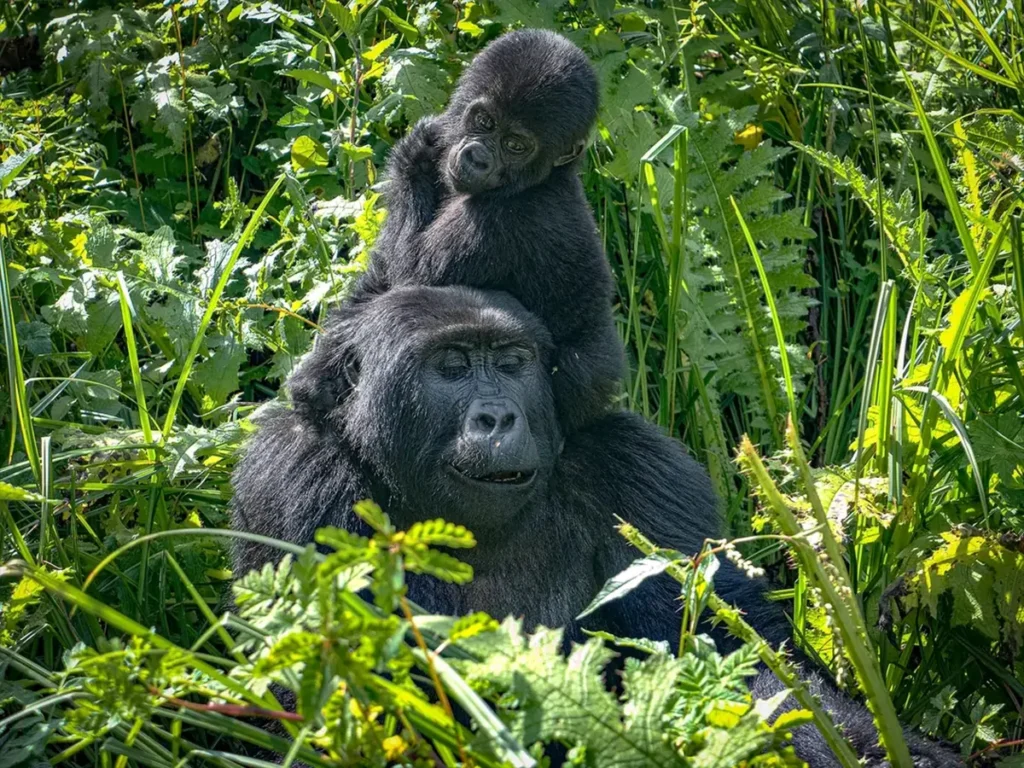Rwanda–Uganda Combined Gorilla Safari
A Rwanda–Uganda combined gorilla safari blends two of Africa’s finest primate destinations into one powerful adventure. The journey connects the volcanic slopes of Rwanda’s Volcanoes National Park with the deep, ancient forests of Uganda’s Bwindi or Mgahinga. Travelers experience two different landscapes, two gorilla families from separate populations, and two styles of trekking. The result is a rich, emotional, and deeply rewarding safari that reveals the full beauty of the Albertine Rift. When you combine the two countries, you expand the depth of your encounter and gain a broader understanding of how each nation protects its gorillas.

Why Travelers Combine Rwanda and Uganda
Rwanda offers quick access, short drives, and a refined trekking system that makes the experience smooth and efficient. Uganda offers wilder, denser forests, longer treks, and a raw atmosphere that feels deeply immersive. Each country delivers a unique gorilla encounter, and combining them allows you to appreciate the contrast. Many travelers choose Rwanda for the first trek because it creates a soft introduction to the mountains. They then continue to Uganda for a second trek that often feels more rugged and adventurous. The combination creates balance, variety, and a deeper emotional journey.
The cross-border route also suits travelers who want to maximize their gorilla experience without repeating the same setting. Rwanda’s Virunga volcanoes rise dramatically above the earth, while Uganda’s Bwindi Impenetrable Forest offers thick vegetation, steep ravines, and ancient tree cover. Experiencing these two worlds in a single safari becomes one of the most memorable primate adventures in East Africa.
Smooth Cross-Border Connection Through Cyanika or Katuna
The border crossing between Rwanda and Uganda remains straightforward when you use the Cyanika or Katuna borders. The drive from Volcanoes National Park to Bwindi or Mgahinga takes only a few hours, and the scenery stays breathtaking throughout. Rolling hills, terraced farms, and quiet rural villages create a peaceful transition between the two countries. Immigration happens quickly when your documents stay ready and your driver-guide handles all formalities.
Travelers often complete their Rwanda trek in the morning, rest overnight in Musanze, and transfer to Uganda the next day. This smooth movement between countries allows you to maintain a comfortable pace without rushing your itinerary. The border connection remains one of the reasons combined safaris work so well.
Experiencing Different Gorilla Populations
Rwanda protects mountain gorillas in the Virunga highlands, while Uganda protects both mountain gorillas and some of the region’s most diverse forest species. The gorilla families move differently in each habitat. Rwanda’s families often stay in open bamboo zones where visibility feels clear. Uganda’s families navigate deeper vegetation, which creates moments of close-up viewing as you follow trackers through thick undergrowth.
Experiencing gorillas in both ecosystems gives you a broader perspective on their behavior, feeding habits, and social interactions. You notice the contrast in the terrain, the type of vegetation they prefer, and the differences in trekking style. Many travelers say the second trek feels even more emotional because they understand the rhythm of the forest more clearly.
Choosing Volcanoes, Bwindi or Mgahinga
A combined safari usually starts in Volcanoes National Park because it sits closer to Kigali International Airport. After the Rwanda trek, you drive into Uganda and continue to either Bwindi Impenetrable Forest or Mgahinga Gorilla National Park. Bwindi offers several trekking sectors—Buhoma, Rushaga, Ruhija, and Nkuringo—each with unique terrain and gorilla families. Mgahinga sits on volcanic slopes similar to Rwanda, which creates a smoother transition for trekkers who enjoyed the Virunga landscape.
Your choice depends on your fitness level, the style of trek you prefer, and the kind of scenery you want to experience. Any route gives you a powerful connection to the gorillas and the forest.
Cost Differences and Permit Benefits
Travelers combine Rwanda and Uganda because the permit prices differ. Rwanda offers a premium trekking experience with a higher permit fee that supports advanced conservation programs. Uganda offers a more affordable permit without lowering the quality of the encounter. Combining the two countries helps you enjoy one premium trek and one cost-effective trek within the same itinerary. This balance makes the overall safari more flexible and accessible.
The difference in price does not change the emotional depth of the experience. The gorillas remain wild, majestic, and unforgettable in both countries. The cost difference simply reflects each nation’s tourism model and conservation structure.
A Deeper Conservation Story Across Borders
A combined gorilla safari tells a powerful conservation story. Rwanda, Uganda, and Congo share the same mountain gorilla population, and their collective protection efforts keep the species thriving. By trekking in both Rwanda and Uganda, you support two national conservation systems that work together to safeguard gorillas, protect forests, and uplift local communities. Your permit contributes to ranger patrols, veterinary programs, community revenue sharing, and habitat restoration.
This cross-border approach strengthens your understanding of how regional conservation works and why gorilla tourism remains one of Africa’s greatest success stories.
Plan a Seamless Rwanda–Uganda Combined Gorilla Safari
A combined safari gives you two landscapes, two trekking styles, and twice the emotional power of the gorilla encounter. When you plan with experts who understand both countries, the journey becomes smooth, enriching, and unforgettable.
Inquire and book your Rwanda–Uganda combined gorilla safari at https://www.gorilla-permits.com.

